Through her work as a board member and registrar at past Camp Brotherhood symposia, Arliss has become recognized as part of the catalytic glue that holds NWSSA together. Perhaps less well known and recognized is her considerable talent as an artist. This interview provides an opportunity to display that side of this multi-talented woman. 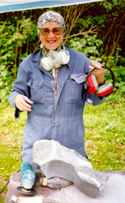
LE: What is your life history as it relates to being an artist?
AN: As a child I wanted to draw great pictures, but my vision or view of an object was never in the flat plane. I always saw things in my mind’s eye in the round. When I was 7 or 8 years old my Father gave me my first pocketknife. He was what people now would call a folk artist. He was a teacher, but as a hobby he whittled chains, pliers and hinged boxes out of one piece of wood and, because they moved, it was like magic. So I became a bit of a whittler too and also a champion (for my age) Mumblety Peg player with my knife. My 3rd grade teacher took it away and said, “Ladies don’t play with knives.” I did get it back, but then, I had never aspired to being a LADY anyway. I was interested in all kinds of art but never stuck to any one thing, possibly for lack of guidance, instruction or opportunity.
I did very little art in my teens and early twenties. Instead, I pursued a career in electronics, in particular, the field of underwater sonar. I went to work for the Honeywell Underwater Lab in Seattle where I met my husband, John. We were fortunate to be able to live aboard our 50 ft. yawl, Gwendolyn II, and sail to many parts of the world over the next 15 years. All the while, I was an avid observer of the art I saw during our travels. In 1975, we decided to give up ocean cruising for boating in the Pacific NW. We brought our boat back to our home waters from the east coast and moved to the marina in Port Townsend.
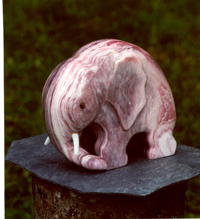
A friend gave me a set of wood-carving tools. I started to carve small animals, little people and walking sticks. Mostly I gave them away to friends and people we would meet. A chance (I think it was fate) meeting one summer with a stone sculptor on an island up in British Columbia started my work in stone. He told me if I could carve wood I could carve stone and he gave me a piece of beautiful multi-colored alabaster and another of Brazilian soapstone - about 5 lbs. each. Both were worked with my wood carving tools. I was hooked! In fact, I have not carved wood since then.
That winter we RV’d to Quartzite, Arizona, the site of one of the largest gem and mineral shows in the U.S. I met a stone vendor selling 10 tons of beautiful carving talc in lots of different colors. I was like a kid in a candy store! I sat outside our RV parked in the desert, and carved up a storm. People would walk by, stop and watch. I sold a lot of coffee table or smaller sized pieces almost before they were finished. Unfortunately, very few were photographed. I was asked to display my carvings in the big gem and mineral show that February. To my surprise, I received the People’s Choice award and sold most of my carvings. Coming back home that spring, our poor RV was groaning from the extra weight of stone stowed in every available space.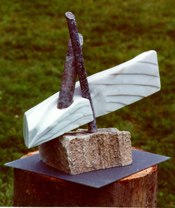
Bob Sahli, who lives near me and is a past member of NWSSA, told me about the organization. In July of 1992, I was able to attend Camp Brotherhood for four days. What a unique experience.
LE: How has NWSSA influenced your work as an artist?
AN: Being fortunate enough to find NWSSA 10 years ago has no doubt been the biggest factor in my being an artist and stone sculptor. Just hanging around a group at Camp B. can really get me excited to try new things. The vast knowledge so generously shared is a big turn on.
Six years ago when Vic Picou asked me to help in the planning of the symposium, I felt it was a great opportunity to give back in some small measure for all the help and support I had received. Being in charge of registration for Camp B. was a good way of getting to know so many interesting people. The last three years as a member of the board of directors, has allowed me to help the organization grow to better meet the needs of its members. I don’t think there is a finer sculpture group in the world.
LE: What is the major theme or intent of your art?
AN: I’m not sure I have a particular style in my sculpture. I look at a piece of stone from all sides and the stone tells me what it wants to be. I think only twice have I carved from a square or cut block of stone. As I said before, I envision forms and figures in the round so I use a marking pen and draw a rough idea directly on the stone. Sometimes what comes out is a very pleasant surprise.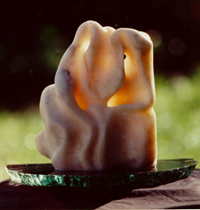
LE: What is the source of inspiration for your forms?
AN: The study of nature has played a large part in my choice of images. I look at the structure of a flower; how each separate petal ties into the other and how beautifully it is engineered. In my head, I take it apart and put it back together in stone. What magic! Just like my father’s woodcarvings were magic when I was a child.
LE: Is your sculpture representational or non-representational?
AN: Always representational until 1993. I met Mark Heisel at Camp B. After looking through my portfolio, he asked me if I had ever carved an abstract piece. I asked, “How do you design an abstract?” “Oh,” he said, “you just relax and listen to the stone and go with the flow.” I had this tall curved piece of Lake Wenatchee soapstone, so I started to work with it. Mark was kind enough to point out how the form and balance was important. It was fantastic to experience the freedom in abstraction. The finished piece became “Flute Song”. I don’t think I ever told him how much his help and encouragement meant to me. “Thank you Mark.” I still sculpt realistic subjects, but it’s fun to find an interesting shaped stone and be able to have that freedom of choice.
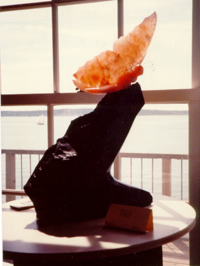
LE: Why is art important to you?
AN: I’ve seen a bumper sticker that reads “ART SAVES LIVES” - that is so true. During a very rough time while my husband was ill, I found working the stone and losing myself in creating something which would be on this earth after we are all gone helped me be a better person.
LE: Do you work part or full time?
AN: I would love to be able to work every day, but the job of just living does seem to take up a lot of time.
LE: How much work do you complete in a year?
AN: Anywhere from 12 to 20 or so. Some are small enough to hold in your hand and others up to 100-120 lbs. After back surgery a couple of years ago, I find it’s easier to work on 30-60 pound finished pieces.
LE: What tools do you use?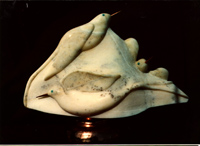
AN: Angle grinders - I use diamond blades both dry and with water. I have a Fordham flex-shaft motor with three different sized hand pieces to do detail work and also a small air hand piece that I am just learning to use. Then, of course, the standard rasps, files and lots of sandpaper.
LE: Where do you exhibit your work?
AN: I try to show in any NWSSA shows. I am a member of the Open Studio & Gallery in Port Townsend. It’s a co-op gallery with 26 members and I am the only stone sculptor. In May, I will be the featured artist. In the past, I have had pieces in galleries in Port Orchard, Anacortes, Kirkland, Tacoma, Seattle, and Tenino.
LE: How is your work area set up?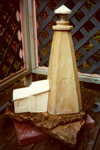
AN: After working in my open carport for 10 years, which meant locking everything away after each session, a wonderful event is soon to happen. Last fall, my partner, Mike, and I bought 4 1/2 acres 5 miles south of Port Townsend. We just ordered a kit pole building, which is due to arrive the end of March. So, sometime this year I will be lucky enough to have my own studio. The job right now is to move all my piles of stone to the property. We have made a start, but until now I hadn’t realized just how much stone I had stockpiled. So Randy, Gary, and Art City please just ignore me if I look at any stone at Camp B. this year.
In the words of Shamus McArt “SCULPT PROUD”
